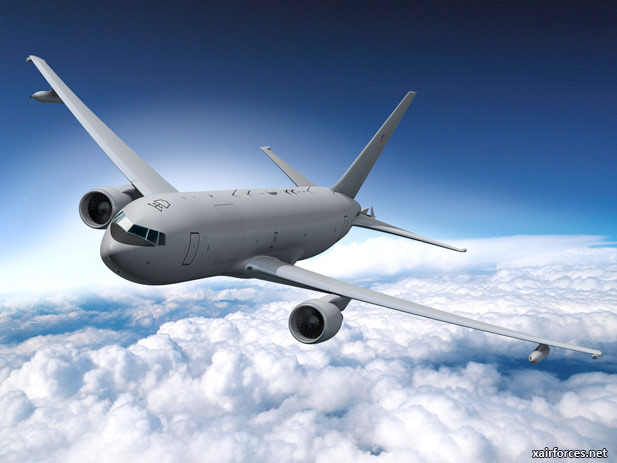
Cobham Body Fuel Tanks selected for KC-46A

Boeing has selected Cobham Mission Equipment to provide Body Fuel Tanks in support of the US Air Force’s KC-46 Tanker programme. Cobham revealed its selection in a 30 January 2012 company statement.
Boeing is providing the US Air Force with 179 KC-46A Tankers initially, under an engineering manufacturing development (EMD) phase that began in January 2012, with low-rate and full-rate production through 2028. Under the Cobham agreement, each aircraft will carry a quantity of four each of the Cobham Body Fuel Tanks.
According to Cobham, the Body Fuel Tanks enable KC-46A mission capability by providing additional fuel for offload and increased range.
Cobham is a key supplier to Boeing on several systems vital to the KC-46 program. In July 2011 Cobham Mission Equipment at Davenport was also awarded two subcontracts by Boeing related to the hose and drogue aerial refueling system that will be used on the KC-46A tanker aircraft. The contracts relate to the EMD phase of the program, including development hardware. Cobham expects to equip each aircraft with a centerline drogue system. Approximately 30 tankers will also be provided with a pair of wing-mounted aerial refueling pods.
Source: By Tony Osborne in London, 30 January 2012 - Mil-Log News (www.shephardmedia.com)
Photo: The The U.S. Air Force KC-46A Tanker is intended to replace the United States Air Force's aging fleet of KC-135 Stratotankers and provides vital air refueling capability for the United States Air Force. (Photo by Courtesy Photo / www.af.mil)
KC-46A TANKER
Mission
The KC-46A is intended to replace the U.S. Air Force's aging fleet of KC-135 Stratotankers which has been the primary refueling aircraft for more than 50 years. With more refueling capacity and enhanced capabilities, improved efficiency and increased capabilities for cargo and aeromedical evacuation, the KC-46A will provide aerial refueling support to the Air Force, Navy, Marine Corps as well as allied nation coalition force aircraft.
Features
The KC-46A will be able to refuel any fixed-wing receiver capable aircraft on any mission. This aircraft is equipped with a modernized KC-10 refueling boom integrated with proven fly-by-wire control system and delivering a fuel offload rate required for large aircraft. In addition, the hose and drogue system adds additional mission capability that is independently operable from the refueling boom system.
Two high-bypass turbofans, mounted under 34-degree swept wings, power the KC-46A to takeoff at gross weights up to 415,000 pounds. Nearly all internal fuel can be pumped through the boom, drogue and wing aerial refueling pods. The centerline drogue and wing aerial refueling pods are used to refuel aircraft fitted with probes. All aircraft will be configured for the installation of a multipoint refueling system.
MPRS configured aircraft will be capable of refueling two receiver aircraft simultaneously from special "pods" mounted under the wing. One crewmember known as the boom operator controls the boom, centerline drogue, and wing refueling pods during refueling operations. This new tanker utilizes an advanced KC-10 boom, a center mounted drogue and wing aerial refueling pods allowing it to refuel multiple types of receiver aircraft as well as foreign national aircraft on the same mission.
A cargo deck above the refueling system can accommodate a mix load of passengers, patients and cargo. The KC-46A can carry up to 18 463L cargo pallets. Seat tracks and the onboard cargo handling system make it possible to simultaneously carry palletized cargo, seats, and patient support pallets in a variety of combinations. The new tanker aircraft offers significantly increased cargo and aeromedical evacuation capabilities.
The aircrew compartment includes 15 permanent seats for aircrew which includes permanent seating for the aerial refueling operator and an aerial refueling instructor. Panoramic displays giving the ARO wing-tip to wing-tip situational awareness.
Background
The Boeing Company was awarded a contract for the Engineering and Manufacturing Development phase of the KC-46 program on Feb. 24, 2011. The initial flight of the KC-46A aircraft is scheduled for late calendar year 2014. The current contract, with options, provides the Air Mobility Command an inventory of 179 KC-46 tankers.
General Characteristics
Primary Function: Aerial refueling and airlift
Prime Contractor: The Boeing Company
Power Plant: 2 Pratt & Whitney 4062
Thrust: 62,000 lbs - Thrust per High-Bypass engine (sea-level standard day)
Wingspan: 157 feet, 8 inches (48.1 meters)
Length: 165 feet, 6 inches (50.5 meters)
Height: 52 feet, 10 inches (15.9 meters)
Maximum Takeoff Weight: 415,000 pounds (188,240 kilograms)
Fuel Capacity: 212,299 pounds (96,297 kilograms)
Maximum Transfer Fuel Load: 207,672 pounds (94,198 kilograms)
Maximum Cargo Capacity: 65,000 pounds (29,484 kilograms)
Pallet Positions: 18 pallet positions
Air Crew: 15 permanent seats for aircrew, including aeromedical evacuation aircrew
Passengers: 58 total (normal operations); up to 114 total (contingency operations
Aeromedical Evacuation: 58 patients (24 litters / 34 ambulatory) with the AE Patient Support Pallet configuration; 6 integral litters carried as part of normal aircraft configuration equipment
(www.af.mil)
(30.01.2012)
|